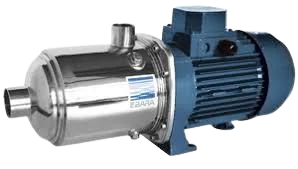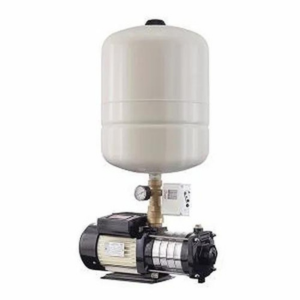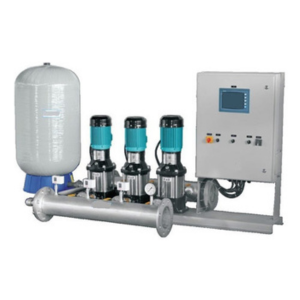
Water Pressure Booster Pumps for Commercial Applications
Are you experiencing low water pressure in your homes? We provide best pressure water pressure booster pump cost effectively and energy efficient.
Water Pressure Booster Pumps for Commercial Applications
Are you experiencing low water pressure in your homes? We provide best pressure water pressure booster pump cost effectively and energy efficient.
Water Pressure Booster Pump For Commercial Applications
Multi-Stage Pressure Booster Pump
Centrifugal Pressure Booster Pump
Centrifugal Pressure Booster Pump
Centrifugal pressure booster pumps utilize a spinning impeller to increase water pressure. These versatile pumps are commonly used for general water supply and irrigation applications.
Working Principle:
As the impeller rotates, it imparts kinetic energy to the water, which is then converted into pressure energy as it exits the pump.
Specifications Table:
| Parameter | Specification |
| Flow Rate | Varies based on mode |
| Pressure Increase | Depends on impeller design |
| Application | General water supply, irrigation |
| Power Source | Electric motor |
| Efficiency | Moderate to high |
| Maintenance | Relatively low |
Multi-Stage Pressure Booster Pump
Multi-Stage Pressure Booster Pump
Multi-stage pressure booster pumps have multiple impellers arranged in series to achieve higher pressure levels. They are often used in high-rise buildings and industrial systems.
Working Principle:
Water passes through each impeller stage, gaining additional pressure before exiting the pump. This staged approach results in significant pressure boosts.
Specifications:
| Parameter | Specification |
| Flow Rate | Varies based on mode |
| Pressure Increase | High, with multiple stages |
| Application | High-rise buildings, industrial systems |
| Power Source | Electric motor |
| Efficiency | High |
| Maintenance | Periodic inspection and maintenance |
Choosing Right Pressure Pump For Commercial Buildings
Choosing the right pressure booster pump for commercial buildings requires careful consideration of various factors to ensure reliable water pressure and flow for all users. Here’s a comprehensive guide to help you make the right choice:
1. Building Size and Layout
-
- Height of the Building: Calculate the vertical lift required to supply water to the highest floor. The pump must overcome the elevation height, typically 0.433 psi per foot of elevation.
- Number of Floors: Consider the number of floors to ensure adequate pressure on the top floors.
2. Water Demand and Flow Rate
-
- Peak Demand: Determine the peak water demand during high usage times. Consider the total number of fixtures (e.g., toilets, sinks, showers) and their flow rates.
- Simultaneous Usage: Calculate the total flow rate required when multiple fixtures are in use simultaneously. This is crucial for selecting a pump with the appropriate capacity.
3. Pump Type and Configuration
-
- Single vs. Multi-Pump Systems: For larger buildings, a multi-pump system with variable speed drives might be necessary to handle varying demand and provide redundancy.
- Inline vs. End-Suction Pumps: Inline pumps are easier to install in confined spaces, while end-suction pumps are more efficient and easier to maintain.
4. Pressure Management and Control
-
- Pressure Tanks: Include pressure tanks to manage pressure fluctuations and reduce pump cycling.
- Pressure Sensors and Controllers: Use pressure sensors and electronic controllers to maintain consistent water pressure and optimize pump operation.
5. Energy Efficiency
-
- Variable Speed Pumps: Consider variable speed pumps that adjust their speed based on demand, improving energy efficiency and extending pump life.
- Energy Consumption: Evaluate the energy consumption of the pump and look for energy-efficient models to reduce operational costs.
6. Reliability and Maintenance
-
- Durability: Choose pumps made from high-quality materials (e.g., stainless steel) for longevity and resistance to corrosion.
- Maintenance Access: Ensure the pump system is easy to access for maintenance and repairs, minimizing downtime.
7. Noise Levels
-
- Noise Reduction: Consider the noise levels of the pump, especially if it is installed near occupied areas. Opt for pumps with noise-reduction features or install soundproofing measures.
8. Redundancy and Backup
-
- Backup Pumps: For critical applications, include backup pumps to ensure continuous water supply in case of primary pump failure.
- Automated Switching: Implement automated systems to switch to backup pumps seamlessly when needed.
9. Water Quality
Debris and Sediment: Ensure the pump is suitable for the water quality in your area. If necessary, install pre-filters to protect the pump from debris and sediment.
10. Local Codes and Regulations
-
- Compliance: Ensure the pump system complies with local building codes and regulations regarding water pressure and plumbing systems.
- Permits: Obtain any necessary permits for installation and operation.
11. Cost and Budget
-
- Initial Cost vs. Long-Term Savings: Balance the initial cost of the pump system with potential long-term savings from energy efficiency and reduced maintenance.
- Total Cost of Ownership: Consider the total cost of ownership, including installation, operation, maintenance, and potential repairs.
FAQ
How do you increase water pressure in a commercial?
Booster pumps are installed in commercial buildings’ water systems to increase water pressure as it travels upwards. These pumps work by adding pressure to the water as it flows through the pipes.
What size water pressure booster pump do I need?
When sizing a domestic booster pump, you need to measure the current water pressure against the amount of pressure that the booster pump can provide. For instance, a building looking to boost water pressure from 20 to 40 psi will require a booster pump capable of producing 20 psi.
Are pressure booster pumps easy to install?
Most pressure booster pumps can be installed by a skilled plumber or technician. However, the complexity of installation can vary depending on the pump type and your specific plumbing setup. Professional installation is often recommended to ensure proper functioning and safety.
Do pressure booster pumps consume a lot of electricity?
The energy consumption of pressure booster pumps varies depending on the type and size of the pump, as well as usage patterns. Variable speed pumps tend to be more energy-efficient since they can adjust their speed according to demand, saving electricity when water usage is low.
How do I maintain a pressure booster pump?
Regular maintenance is essential to keep your pressure booster pump operating efficiently. This includes checking for leaks, inspecting and cleaning filters, lubricating moving parts (if applicable), and ensuring electrical connections are secure. Refer to the manufacturer’s guidelines for specific maintenance instructions.
What should I do if my pressure booster pump is making unusual noises or not working correctly?
If you notice unusual noises or a drop in performance, it’s important to contact a professional technician or plumber to diagnose and repair any issues promptly. Delaying repairs can lead to more significant problems.


